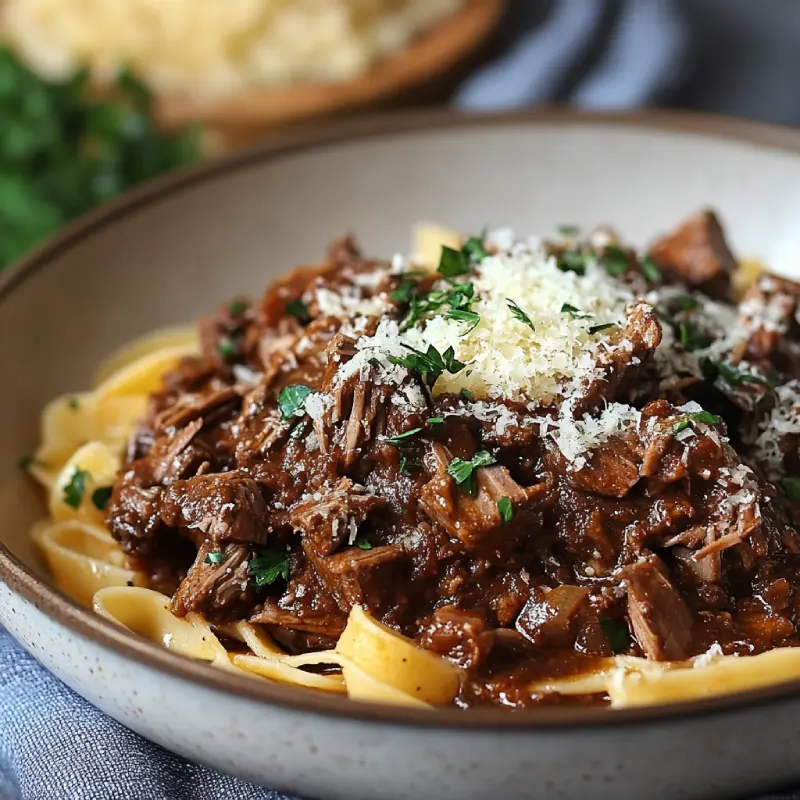Introduction and Recipe Overview
Introduction to Bison and Wild Boar Ragu (200 words)
Bison and wild boar are two types of game meat that have been prized for their rich flavors and nutritional benefits throughout history. Originating from different parts of the world—bison primarily from North America and wild boar from Europe and Asia—both meats are celebrated in various culinary traditions for their deep, robust flavors. Combining bison and wild boar in a ragu creates a dish that is hearty and flavorful, making it perfect for enriching pastas, polentas, or other substantial meals. This fusion not only melds the distinct tastes of the two meats but also pays homage to a rustic, traditional cooking style that enhances the natural flavors of the ingredients.
Ingredients Overview (300 words)
To prepare a savory bison and wild boar ragu, you’ll need the following primary ingredients:
- Meat: Bison and wild boar, preferably sourced from reputable suppliers to ensure quality and sustainability.
- Vegetables: Basic aromatic vegetables like onions, carrots, and celery form the foundational flavor base.
- Aromatics: Garlic, bay leaves, and possibly herbs like rosemary or thyme to enhance the meaty flavors.
The success of the ragu heavily relies on the quality of the meat and the freshness of the produce. Using high-quality, well-sourced bison and wild boar ensures that the ragu has a rich and appealing taste, while fresh vegetables contribute to the overall depth of the dish. These ingredients come together under slow cooking to create a complex and hearty sauce that’s perfect for colder months or any occasion requiring a comforting meal.
Preparing the Ragu
Marinating the Meat (300 words)
Marinating the bison and wild boar is a crucial step to enhance both the flavor and tenderness of the meats before they are cooked into the ragu. Here’s how to prepare a flavorful marinade:
- Ingredients:
- Red wine: Provides acidity to tenderize the meat and depth of flavor.
- Herbs: Rosemary, thyme, and bay leaves infuse aromatic notes.
- Garlic and onions: For additional flavor layers.
- Olive oil: Helps to bind the marinade and coat the meat evenly.
- Marination Process:
- Combine Ingredients: In a large bowl, mix red wine, chopped herbs, minced garlic, sliced onions, and olive oil.
- Add Meat: Place the bison and wild boar meat into the marinade. Ensure that the pieces are well-coated and submerged.
- Refrigerate: Cover the bowl and refrigerate for at least 12 hours, preferably 24, to allow the flavors to penetrate deeply.
The acidity of the wine and the flavors from the herbs and garlic help to soften the meat fibers, resulting in a more tender and flavorful ragu. The longer marination time also allows the complex flavors to meld together, creating a richer base for the ragu.
Cooking Techniques (400 words)
The cooking technique for bison and wild boar ragu is essential to maximize flavor extraction and achieve perfect tenderness.
- Slow-Cooking Process:
- Brown the Meat: Remove the meat from the marinade and pat dry. Brown it in a heavy pot with a little oil to develop a rich flavor foundation.
- Sauté Vegetables: In the same pot, sauté onions, carrots, and celery until soft.
- Deglaze: Use a bit of the marinade to deglaze the pan, scraping up any browned bits from the bottom.
- Add Remaining Ingredients: Return the meat to the pot, add any leftover marinade, and cover with stock or water.
- Simmer Slowly: Bring to a simmer, then reduce the heat to low. Cover and let cook slowly for several hours, stirring occasionally.
- Benefits of Slow Simmering:
- Flavor Development: The slow simmering process allows for a full extraction of flavors from the meat, herbs, and vegetables.
- Tenderness: Long, slow cooking breaks down the tough fibers in the bison and wild boar, resulting in melt-in-your-mouth tenderness.
- Heat Management:
- Maintain Low Heat: It’s crucial to keep the cooking temperature low to prevent the sauce from burning and to ensure that the meat cooks gently and evenly.
Enhancing Flavor and Texture
Flavor Enhancements (300 words)
Enhancing the flavor of bison and wild boar ragu involves careful selection and application of spices and seasonings to complement the naturally robust taste of these meats. Here’s how to elevate your ragu with strategic flavor enhancements:
- Selecting Spices and Seasonings: Choose spices that match the strong flavors of game meats without overpowering them. Paprika, cumin, and coriander are excellent for adding depth, while black pepper provides a subtle heat.
- Using Fresh Herbs: Incorporate herbs like sage, rosemary, and thyme, which are robust enough to stand up to long cooking times and complement the rich flavors of bison and wild boar.
- Adding Umami Components: For an umami boost, consider stirring in a tablespoon of tomato paste or a few anchovies into the sauce. These ingredients meld into the ragu, deepening the overall flavor profile without dominating the dish.
Textural Adjustments (300 words)
Achieving the perfect consistency in your ragu is as important as flavor. Here are some tips for textural adjustments during the cooking process:
- Controlling Cooking Time and Temperature: Slow cook the ragu at a low simmer. This gentle cooking method helps the meat become tender without disintegrating.
- Adjusting Thickness: If the ragu is too thin after cooking, consider simmering it uncovered for a few additional minutes to reduce the liquid. Conversely, if it’s too thick, add a splash of stock to thin it to your desired consistency.
- Stirring and Skimming: Regularly stir the ragu to prevent sticking and skim off any excess fat that rises to the surface, which can affect the texture and mouthfeel of the final dish.
Serving and Pairing
Serving Suggestions (200 words)
Properly plating bison and wild boar ragu not only enhances its visual appeal but also its taste. Here are some best practices and ideas for serving this hearty dish:
- Plating the Ragu: Serve the ragu over a bed of freshly cooked pasta or soft, creamy polenta to absorb the sauce and complement its rich flavors. Choose pasta shapes like pappardelle or tagliatelle which are ideal for holding onto the thick sauce.
- Garnishing: Sprinkle with grated Parmesan or pecorino cheese and add a few fresh basil leaves or chopped parsley to add color and freshness to the dish.
- Accompaniments: Serve alongside a bowl of crusty bread to scoop up any remaining sauce. This not only adds texture but also ensures none of the delicious sauce goes to waste.
Wine and Beverage Pairings (200 words)
Selecting the right wines and beverages to accompany your ragu can enhance the dining experience by complementing its rich flavors:
- Red Wines: Opt for bold, robust reds such as Barolo, Chianti, or a Shiraz. These wines have the body and tannic structure to balance the richness of the game meats.
- White Wines: If you prefer white, choose a full-bodied white like Chardonnay, which can stand up to the strong flavors of the ragu without being overwhelmed.
- Other Beverages: For a non-alcoholic option, consider a rich, dark grape juice or a sparkling water infused with herbs like rosemary or basil to maintain the meal’s rustic feel.
Each pairing should enhance both the dish and the drink, creating a harmonious blend of flavors that elevates the overall meal.
Frequently Asked Questions
Here are some answers to common questions about making bison and wild boar ragu:
- Can I substitute other meats for bison or wild boar?
- Yes, if bison or wild boar are not available, you can substitute with beef or pork. Keep in mind that these meats may have a milder flavor, so you might want to adjust the seasoning to compensate.
- What if the ragu is too thick or too thin?
- If the ragu is too thick, you can thin it by adding a bit more broth or water during the cooking process. If it’s too thin, let it simmer uncovered for a longer period to reduce and thicken the sauce.
- How long should I cook the ragu?
- Cooking times can vary depending on the cut of the meat and your cooking method. Generally, slow cooking on a low heat for several hours will yield the most tender and flavorful results. If using a slow cooker, you can set it to cook for 6-8 hours on low.
- Can this ragu be made ahead of time?
- Absolutely! Making the ragu a day ahead can actually enhance its flavors as the ingredients have more time to meld together. Simply reheat it slowly on the stove, adjusting the consistency if necessary.
- What are the best ways to serve bison and wild boar ragu?
- This ragu pairs wonderfully with wide pasta like pappardelle or with polenta. It’s also great served over mashed potatoes or as a filling for a hearty pie.
Conclusion
Crafting the perfect bison and wild boar ragu is an adventurous culinary journey that blends robust flavors with rich textures. Here are some key takeaways from our exploration of this hearty dish:
- Flavor Depth: Utilizing game meats like bison and wild boar introduces a depth of flavor that is unmatched by more common meats. Marinating and slow cooking these meats enhances their natural tastes and tenderizes them beautifully.
- Versatility in Serving: Whether spooned over pasta, layered on polenta, or used as a pie filling, bison and wild boar ragu is incredibly versatile and adapts well to various serving options.
- Advance Preparation: Preparing this ragu a day in advance can deepen the flavors even more, making it a perfect dish for meal planning or special occasions.
Embrace the process of experimenting with this ragu, adjusting spices and cooking times to suit your taste. Each batch can be a new discovery in flavor and texture.

